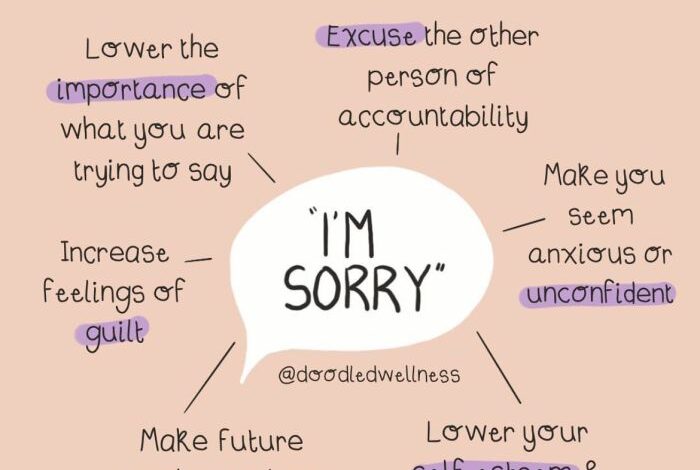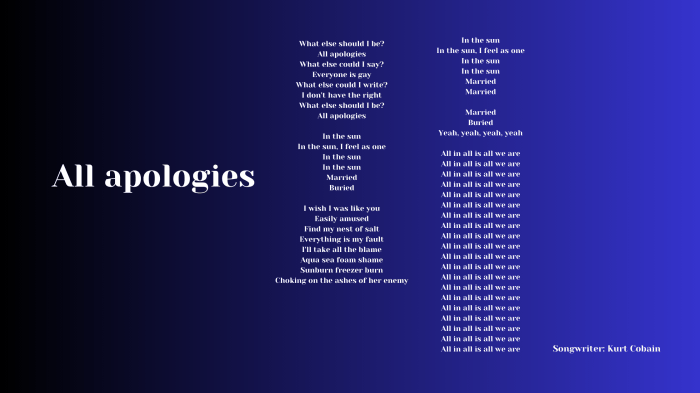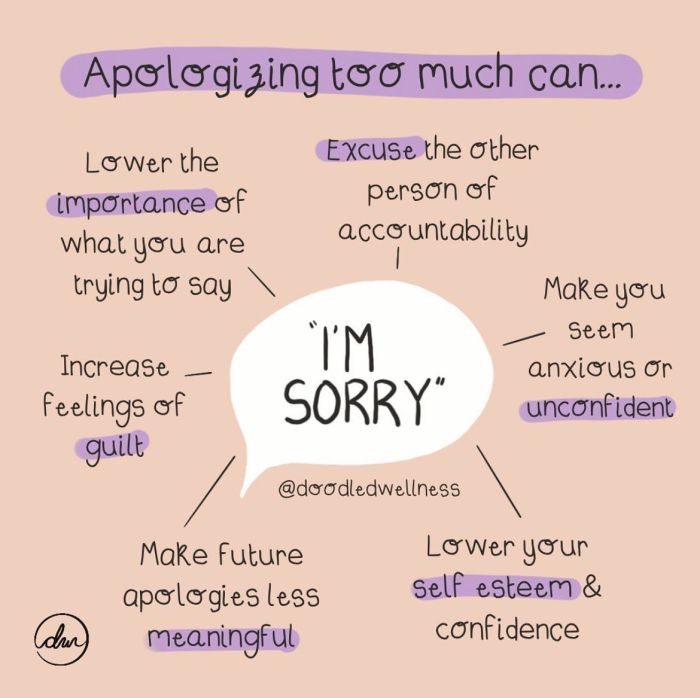
Apologies around the world are a fascinating exploration of cultural nuances. From the subtle nods and murmured regrets of some cultures to the direct and heartfelt expressions of others, understanding how apologies are conveyed is crucial for effective communication and bridging cultural gaps. This journey delves into the intricate ways societies express remorse, examining the historical context, different situations where apologies are crucial, the methods used, and the impact they have on relationships.
This blog post will explore how cultural norms, historical events, and various contexts shape the art of apologizing. We’ll examine specific examples and situations, from personal relationships to professional settings and even public apologies from nations. We’ll also analyze the psychological effects of apologies on both the giver and receiver and look at strategies for making apologies more effective.
Cultural Nuances in Apologies
Apologies, a seemingly simple act, can carry vastly different meanings and implications across cultures. Understanding these nuances is crucial for effective communication and building positive relationships in a globalized world. From the directness of an expression to the unspoken weight of social hierarchy, cultural context plays a significant role in how apologies are given and received. This exploration delves into the intricate tapestry of apology etiquette worldwide.The concept of an apology is not universally defined.
While the core intent—to express remorse and repair harm—remains consistent, the methods and expectations surrounding its delivery vary considerably. This divergence stems from deeply ingrained cultural values, social norms, and historical contexts, shaping how individuals express regret and seek reconciliation.
Varying Levels of Directness
Different cultures employ varying degrees of directness when expressing remorse. Some cultures prioritize direct and explicit apologies, while others favor more indirect or nuanced approaches. This difference reflects varying cultural values and communication styles. For example, in some cultures, a simple “I’m sorry” might suffice, while in others, a lengthy explanation or a series of actions may be necessary to convey sincerity.
Different Ways Apologies are Conveyed
| Culture | Nonverbal Cues | Specific Phrases |
|---|---|---|
| Japan | Bowing deeply, avoiding eye contact, offering gifts | “Gomen nasai” (I’m sorry), expressions of shame and humility |
| United States | Eye contact, verbal acknowledgement, offering assistance | “I’m sorry,” “I apologize,” expressions of regret |
| China | Maintaining composure, acknowledging fault implicitly | “Bù hǎo” (Not good), indirect apologies, emphasis on rectification |
| Latin America | Emphasis on emotional displays, hugs, gestures of affection | “Lo siento” (I’m sorry), expressions of empathy |
This table highlights some key distinctions in apology practices across cultures. Notice how nonverbal cues often play a significant role in conveying remorse, alongside specific verbal phrases. These examples demonstrate the rich diversity in expressing regret globally.
Importance of Face-Saving
Face-saving, a crucial aspect of many cultures, plays a vital role in apology practices. Maintaining one’s reputation and avoiding embarrassment is paramount in certain societies. Apologies in these contexts often prioritize indirectness to avoid directly acknowledging fault, thereby preserving the face of both the offender and the offended. This is often evident in collectivist cultures where group harmony is highly valued.
Role of Social Hierarchy
Social hierarchy profoundly influences apology behaviors. In cultures with strong hierarchical structures, the person of higher status may expect a more formal and respectful apology from someone of lower status. The degree of formality and deference shown in the apology can reflect the power dynamics between the individuals involved. This often translates to a more indirect apology from the subordinate, emphasizing respect for the superior.
For instance, in some Asian cultures, an apology from a subordinate to a superior might involve a combination of verbal expressions and physical gestures like bowing, emphasizing the importance of respecting social standing.
Historical Context of Apologies

Apologies, as a crucial aspect of interpersonal and international relations, have a rich and complex history. Their forms, motivations, and effectiveness have evolved significantly over time, reflecting changing societal norms, political landscapes, and technological advancements. Understanding this historical context is vital to appreciating the nuances of contemporary apologies and their potential impact.Historical apologies are not simply expressions of regret; they are often complex acts with profound consequences.
They can range from private expressions of remorse to formal, public pronouncements, and can signify a nation’s or individual’s commitment to repairing harm and building trust.
Timeline of Significant Historical Apologies
A timeline of significant historical apologies reveals the evolving nature of this practice. These apologies often address atrocities, injustices, and historical grievances, shaping international relations and influencing the development of modern apology protocols. The progression from simple expressions of regret to structured, formal declarations reflects a growing awareness of the importance of accountability and reconciliation.
- 1979: The Japanese government’s apology for the comfort women issue during World War II. This apology, while not the first, marked a turning point in acknowledging and addressing the historical injustices committed during the war. It acknowledged the suffering of victims and laid the groundwork for future apologies and reparations.
- 1993: The German government’s apology for Nazi atrocities. This apology was significant for its scope and impact. It was a public acknowledgement of the devastating consequences of the Nazi regime and signaled a commitment to confronting the past and fostering reconciliation.
- 2000: The United States’ formal acknowledgement of the Tuskegee Syphilis Study. This was a pivotal example of a public apology addressing the profound ethical and medical violations against African American participants. It served as a model for future apologies that addressed systemic failures.
Evolution of Apology Practices Over Time
The practice of apologizing has undergone a dramatic evolution. Early apologies were often private or informal, with little emphasis on public acknowledgment or formal redress. However, as societies became more complex and interconnected, the need for public apologies for historical injustices grew. This evolution reflects the increasing awareness of the importance of accountability and the need for redress for past wrongs.
Apologies, it seems, are a universal human experience, though the specifics of expressing remorse vary wildly across cultures. Thinking about how different cultures handle apologies, it’s fascinating to consider how a device like the Motorola XOOM, designed for heavy meddling, motorola xoom designed for heavy meddling , might have changed the way we communicate our regrets. Ultimately, the core message of an apology, regardless of the method, remains the same – acknowledging fault and seeking reconciliation.
Factors Influencing the Development of Apology Norms
Several factors have influenced the development of apology norms throughout history. These factors include shifting political climates, evolving social norms, and the rise of international organizations. The need for reconciliation, restoration of trust, and the prevention of future harm are key motivations.
- Shifting Political Landscapes: Changes in political power and ideology often dictate the nature and extent of apologies. For example, the fall of totalitarian regimes sometimes led to the acknowledgement of past atrocities by successor governments.
- Evolving Social Norms: Growing awareness of human rights and ethical standards has increased the pressure for apologies in cases of wrongdoing. This pressure is often amplified by advocacy groups and civil society organizations.
- Rise of International Organizations: International bodies like the United Nations have played a role in shaping apology norms, emphasizing the importance of accountability and reconciliation in international relations.
Challenges in Issuing Public Apologies in Historical Contexts
Issuing public apologies in historical contexts presents significant challenges. These challenges include the complexities of determining responsibility, the potential for disagreements about the extent of harm, and the difficulty of balancing the need for acknowledgment with practical considerations. The political ramifications can be considerable.
- Determining Responsibility: Accurately assigning responsibility for past events can be complex and contentious. This can be especially true in cases involving multiple actors and shifting political power dynamics.
- Extent of Harm: Determining the full extent of harm caused by past actions is often difficult, especially in cases involving long periods of time or complex events.
- Balancing Acknowledgement and Practical Considerations: Apologies must strike a balance between acknowledging past wrongdoings and practical considerations such as reparations, reconciliation efforts, and the prevention of future harm.
Motivations Behind Historical Apologies
Various motivations underlie historical apologies. These range from the desire for reconciliation to the need for political expediency. Understanding these motivations provides crucial insight into the context and implications of apologies.
Apologies, it seems, are a universal human experience, though their expression varies widely across cultures. Think about how different societies handle public missteps. Meanwhile, IBM’s ambitious project to create a massive computer system to handle the enormous data output from large telescopes like the James Webb, as detailed in this article , highlights the growing need for sophisticated technology to process information.
Ultimately, whether we’re navigating social situations or astronomical discoveries, effective communication and understanding remain key elements in resolving conflicts and misunderstandings.
| Motivation | Description |
|---|---|
| Reconciliation | A desire to repair fractured relationships and foster understanding between groups or nations. |
| Political Expediency | A strategic decision to gain political support or improve international relations. |
| Moral Responsibility | A recognition of ethical obligations to acknowledge and address past wrongdoing. |
| Pressure from Civil Society | Public pressure and advocacy from affected groups. |
Apologies in Different Contexts
Apologies are a crucial aspect of human interaction, bridging gaps and fostering understanding. Their effectiveness hinges on the context in which they are offered, ranging from personal relationships to formal public statements. Understanding these nuanced contexts is key to crafting apologies that resonate with the recipient and promote reconciliation.
Situations Requiring Apologies, Apologies around the world
Apologies are vital in numerous situations. They are essential when harm has been caused, whether intentional or unintentional. This includes acts of negligence, hurtful words, or breaches of trust. They are also critical for maintaining healthy relationships and restoring harmony after conflict. A sincere apology can mend fences, rebuild trust, and foster a more positive atmosphere.
- Personal Relationships: Arguments, betrayals, and hurtful words often necessitate apologies to mend the bond. Repairing these connections requires a clear acknowledgment of wrongdoing and a genuine commitment to change.
- Professional Settings: Mistakes in the workplace, such as errors in judgment or poor communication, can damage professional reputation and relationships. Apologies in these contexts should be direct, specific, and focused on rectifying the situation.
- Public Apologies: Public apologies, often in response to major transgressions or scandals, are crucial for rebuilding public trust. These require a detailed explanation of the offense and a commitment to change, as well as an acknowledgment of the impact on those affected.
- Misunderstandings: Miscommunication and misinterpretations can lead to conflict. Apologies in these situations often involve clarifying intentions and acknowledging the other person’s perspective.
- Financial Obligations: Failure to fulfill financial commitments, such as missed payments or breaches of contracts, necessitates an apology and a plan for rectifying the situation.
Comparing Apology Strategies
The appropriateness of different apology strategies varies significantly depending on the context. A casual apology might suffice in a close friendship, while a more formal, structured approach is needed in a professional setting or public arena. The key is to tailor the approach to the specific situation and the relationship involved.
| Context | Appropriate Apology Strategy |
|---|---|
| Personal Relationships | Sincere, empathetic, and focused on repairing the relationship. May include an explanation of the cause and a commitment to change. |
| Professional Settings | Direct, specific, and focused on rectifying the mistake. Should include a clear plan for avoiding future issues. |
| Public Apologies | Formal, detailed, and acknowledging the impact on the public. Should include a commitment to addressing the root causes and prevent future similar incidents. |
Effective Apologies in Formal Settings
Effective apologies in formal settings demand a structured approach. They must be clear, concise, and focused on the specific offense. The apology should acknowledge the harm caused and express remorse for the actions. A detailed plan for preventing future issues is also crucial.
“A formal apology should clearly state the mistake, acknowledge the impact it had on others, and Artikel concrete steps to prevent similar incidents in the future.”
Effective Apologies in Interpersonal Relationships
Effective apologies in interpersonal relationships prioritize empathy and understanding. They should go beyond simply saying “sorry” and address the hurt caused. Active listening and demonstrating understanding of the other person’s feelings are key elements. Acknowledging the impact of the actions on the other person and offering a sincere commitment to change are essential.
“An effective interpersonal apology requires empathy, acknowledging the impact on the other person, and a genuine commitment to prevent future hurt.”
Examples of Apologies in Various Social Settings
Apologies demonstrate adaptability. A friend might say, “I’m so sorry I forgot your birthday. I really messed up, and I hope you can forgive me.” In a professional context, a manager might say, “I deeply regret the error in the project timeline. I’ve taken steps to prevent future delays, and I’ve scheduled a meeting to discuss the revised schedule.” A public figure might issue a statement acknowledging the mistake and expressing remorse for the public’s concern, offering concrete plans to address the issues.
Methods and Forms of Apology: Apologies Around The World

Apologies, a crucial aspect of interpersonal relationships, vary significantly in their delivery. They transcend simple verbal expressions and encompass a spectrum of methods, from formal written statements to subtle nonverbal gestures. Understanding these diverse forms and the underlying principles of sincere apologies is essential for effective communication and conflict resolution.Effective apologies often require a delicate balance between acknowledging wrongdoing and demonstrating genuine remorse.
This involves recognizing the impact of one’s actions on others, a crucial component in the restorative process. The approach to conveying an apology should be tailored to the specific context and relationship involved, ranging from casual conversations to official public statements.
Different Methods of Conveying Apologies
Apologies can be communicated through various channels, each with its own nuances. Verbal apologies, while direct, can be easily misinterpreted without the accompanying sincerity and acknowledgement of impact. Written apologies, on the other hand, allow for careful consideration and a more detailed explanation of the situation, although they may lack the immediate feedback and emotional connection of a spoken apology.
Nonverbal cues, such as a sincere expression of regret or a gesture of amends, can often convey remorse more powerfully than words alone.
Forms of Apologies: A Comparative Overview
The table below highlights the spectrum of apology forms, categorized as formal or informal. The effectiveness of each form hinges on the specific context and the relationship between the parties involved.
| Form of Apology | Description | Example |
|---|---|---|
| Verbal Apology (Informal) | Direct and spontaneous expressions of regret. | “I’m so sorry for being late. I messed up my schedule.” |
| Verbal Apology (Formal) | More structured and often delivered in a formal setting, like a public address or a meeting. | “On behalf of the company, I would like to sincerely apologize for the recent incident.” |
| Written Apology (Informal) | A note, text message, or email expressing remorse. | “Hey, I’m really sorry for forgetting your birthday. I hope you’re not too upset.” |
| Written Apology (Formal) | A detailed letter, a public statement, or a formal document. | “We deeply regret the harm caused by our recent policy changes and are committed to making amends.” |
| Nonverbal Apology | Actions and gestures demonstrating remorse, such as a gift, a helping hand, or a sincere look. | Offering a helping hand to someone you’ve accidentally bumped into, or a silent acknowledgement of wrongdoing followed by a sincere effort to repair the damage. |
Sincerity in Apologies
A crucial element of a meaningful apology is sincerity. A perceived lack of sincerity can negate the positive impact of an apology and even escalate the conflict. Genuine remorse stems from an internal recognition of fault and a willingness to change.
“A sincere apology acknowledges the pain caused and expresses a commitment to rectify the situation, not just an admission of fault.”
Acknowledging the Impact on Others
Effective apologies not only acknowledge the wrongdoing but also address the impact it had on the other person or people involved. This includes recognizing their feelings and offering a genuine understanding of their perspective. By acknowledging the hurt or inconvenience caused, an apology demonstrates empathy and respect for the other party.
Common Mistakes in Offering Apologies
People often make errors in expressing apologies, hindering their effectiveness. These include being overly defensive, making excuses, or providing justifications instead of accepting responsibility. A common mistake is to offer an apology without any effort to repair the damage caused. Similarly, an apology without an actionable plan to prevent future similar issues can be perceived as insincere.
The Impact of Apologies
Apologies, while seemingly simple acts, carry significant psychological weight for both the person offering the apology and the person receiving it. They can be powerful tools for healing, rebuilding relationships, and fostering understanding. However, the effectiveness of an apology depends on several factors, including the sincerity behind it and the context in which it’s given. This exploration dives into the profound effects of apologies on individuals and relationships.
Apologies, it seems, are quite a global affair, with nuances and customs varying wildly across cultures. This fascinating exploration of how apologies are delivered worldwide is something we’ll be diving deeper into. Speaking of diverse approaches, I’m particularly interested in the discussion surrounding “burying conventional wisdom at the next web conference” burying conventional wisdom at the next web conference.
Perhaps we can find some parallels between the ways we offer apologies and how we approach innovation in the digital age. Ultimately, understanding the global tapestry of apologies can teach us a lot about communication and cultural understanding.
Psychological Effects on the Giver and Receiver
Apologies can evoke a range of emotions in both the person offering and receiving them. For the giver, a sincere apology can bring a sense of relief and closure. It allows them to acknowledge their wrongdoing and potentially reduce feelings of guilt or shame. Conversely, an insincere apology can reinforce negative feelings and damage trust. For the receiver, a heartfelt apology can lead to feelings of validation, understanding, and acceptance.
However, a poorly executed apology can cause further hurt and resentment, especially if it lacks empathy or acknowledgement of the harm caused. A sincere apology, however, can facilitate healing and a path towards reconciliation.
The Role of Empathy in Effective Apologies
Empathy is crucial for effective apologies. It requires the giver to understand the impact of their actions on the receiver, to see the situation from their perspective, and to acknowledge the pain they have caused. A truly empathetic apology acknowledges the hurt feelings and seeks to understand the receiver’s experience. Without empathy, an apology can feel dismissive or invalidating, hindering the process of reconciliation.
Empathy allows the apology to be more impactful and fosters a stronger connection between the parties involved.
The Process of Reconciliation Following an Apology
Reconciliation is a process, not an instantaneous event, that follows a sincere apology. It requires active listening, patience, and a willingness from both parties to work towards rebuilding trust. The receiver needs to feel heard and understood, and the giver needs to be prepared to make amends. This can involve specific actions, like repairing the damage caused by the transgression, or demonstrating ongoing commitment to repairing the relationship.
The process can vary greatly depending on the severity of the offense and the nature of the relationship.
Examples of Successful Apologies and Their Outcomes
Numerous examples demonstrate the power of sincere apologies. In many high-profile cases, apologies have led to shifts in public opinion, reconciliation, and even legal resolutions. For instance, a public apology from a company for a product defect can mitigate negative publicity and rebuild consumer trust. Likewise, an apology from a political figure for a controversial statement can repair damaged relationships with constituents and restore credibility.
The outcomes of these apologies demonstrate the potential for healing and growth that can follow sincere acknowledgment of wrongdoing.
Impact of Apologies on Relationships
| Relationship Type | Positive Impacts | Negative Impacts |
|---|---|---|
| Personal Relationships (e.g., Friendships, Family) | Increased trust, stronger bonds, deeper understanding, reduced conflict | Damaged trust, resentment, further alienation, potential for relationship breakdown if apology is insincere or insufficient |
| Professional Relationships (e.g., Colleagues, Boss-Employee) | Improved collaboration, enhanced teamwork, strengthened reputation, clearer communication | Loss of credibility, diminished respect, decreased productivity, potential for career setbacks if apology is perceived as weak |
| Inter-group Relationships (e.g., Political, Cultural) | Healing of divisions, social harmony, fostering understanding, promoting inclusivity | Further polarization, deepening conflict, perpetuation of stereotypes, possible escalation of tensions if apology is poorly received |
Apology in Specific Industries/Situations
Apologies are crucial in maintaining positive relationships and mitigating damage in various professional settings. A sincere and well-executed apology can restore trust, improve reputation, and prevent further conflict. Understanding how apologies function within different industries and situations is vital for effective communication and conflict resolution.Effective apologies are not just about saying “sorry”; they involve acknowledging wrongdoing, understanding its impact, and committing to rectifying the situation.
This necessitates a nuanced approach tailored to specific contexts. Different industries demand different communication styles, and a standardized approach might not be effective in every case. The focus should be on conveying empathy, responsibility, and a commitment to improvement.
Apology in Business and Professional Settings
Effective apologies in business are essential for maintaining client trust and professional relationships. They demonstrate accountability and commitment to upholding ethical standards. A timely and appropriate apology can prevent damage to reputation and foster a more positive work environment. Business apologies should be clear, concise, and focused on the specific issue.
Apology in Customer Service Interactions
Customer service interactions frequently necessitate apologies. A sincere apology can diffuse negative situations, restore customer trust, and potentially salvage a relationship. In customer service, apologies should be empathetic, acknowledging the customer’s frustration and inconvenience. Explanations for the error should be brief and easily understandable. Offer concrete solutions, like refunds, replacements, or discounts, to demonstrate a commitment to fixing the problem.
Apology Procedures in Healthcare
Healthcare settings demand a delicate balance between patient care and accountability. Apologies in healthcare are crucial for addressing medical errors, ensuring patient safety, and rebuilding trust. Structured apology procedures are vital to ensure consistency and transparency. These procedures should be in place to guide staff in addressing medical errors, including the acknowledgment of fault, the expression of regret, and a plan for preventing future incidents.
The apology should focus on the patient’s experience and the steps being taken to prevent similar events.
Apology in Legal Contexts
Apologies in legal contexts can have a significant impact, potentially influencing settlements and judgments. A well-structured apology in a legal setting should be carefully considered, as it could impact the outcome of the case. It should clearly acknowledge the wrongdoing and express remorse, but it shouldn’t admit guilt unless the individual or organization is willing to accept full responsibility.
Legal counsel should guide any apologies in these contexts.
Apology Strategies Tailored for Specific Professions/Industries
| Profession/Industry | Apology Strategy | Specific Considerations | Example ||—|—|—|—|| Customer Service | Empathetic acknowledgment, clear explanation, concrete solutions. | Tone of voice, body language, immediacy of response. | “I understand your frustration, and we sincerely apologize for the inconvenience. We will process a full refund and send you a replacement item within 24 hours.” || Healthcare | Sincere expression of regret, acknowledgment of impact on patient, clear steps for preventing future issues.
| Maintaining confidentiality, involving appropriate parties, and following established protocols. | “We are deeply sorry for the error in your care. We have reviewed our protocols and have implemented changes to prevent similar occurrences. We’re committed to providing the best possible care.” || Finance | Honest admission of mistake, clear explanation, commitment to prevention. | Transparency, adherence to regulations, possible financial compensation.
| “We acknowledge the error in processing your transaction and sincerely apologize for the delay. We have adjusted your account balance, and we’ve implemented new systems to prevent future issues.” || Technology | Prompt acknowledgment, clear explanation, proactive communication about solutions. | Speed of response, technical expertise, and potential system updates. | “We understand the disruption this service outage caused.
We are actively working on resolving the issue and will provide updates as they become available. We sincerely apologize for the inconvenience.” |
Epilogue
In conclusion, apologies around the world reveal a complex tapestry of cultural values and historical influences. From subtle nonverbal cues to formal pronouncements, the act of apologizing, while seemingly simple, is a rich and nuanced practice. Understanding these intricacies allows for more empathetic communication and ultimately fosters stronger connections across cultures. We’ve learned how different contexts and situations call for varying approaches to expressing remorse and how the power of a sincere apology can mend relationships and build trust.






